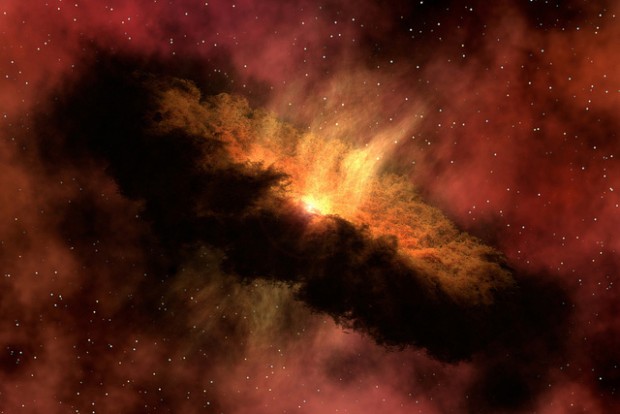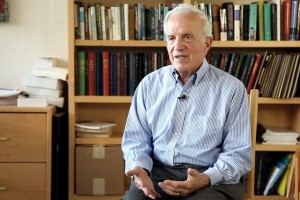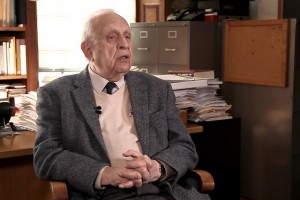Cosmic Microwave Background Polarization
Physicist Lyman Page on thermal radiation, quadrupolar distribution, and the early Universe
The video is a part of the project British Scientists produced in collaboration between Serious Science and the British Council.
When we look at the solar system, there is an amazing structure. We have those small telluric planets inside and big giant planets outside. I think this is a very important element to understand — formation of solar system. It has been used to develop a full theory of how planets are being formed.
The idea starts from the very beginning, when you form a star there are a lot of material around. And this material gets organized in a shape of a disc. It’s called a protoplanetary disk. The reason of why we have this is because there is a law in physics which is called ‘the angular momentum conservation’, which says that if there is something that rotates a little bit when it starts to shrink than the rotation speeds up. When you speed up the rotations practically all the material is falling into the disc and you end up with a rotating disc.
You have this at the beginning of the formation of the solar systems and we do have a picture of young stars where we see this. Everybody agrees that this is in a way the starting point – when you form the planet. When it becomes interesting is what is going on in the disc. You have the stars and you have the disk. The disk has the same kinds of ingredients as the stars. It means that most of the disc is gas, the same gas we have in the Sun, which is hydrogen, helium, and there is a little bit of CO. And then, the rest of it is a little bit of ingredients called silicates, we call them dust, just tiny stuff.

And this is a disc. What happens in this disc is all these materials start to glue together, they stick, there is no gravity, they just meet slowly and they stick together very slowly. If you look at the temperature in the disc, you understand that if you are very close to the star it’s very hot, if it’s very far apart – it’s very cold. There is a distance which you can compute that if there is some ice or there is some water depending on if it’s closer it will become gas, if it’s farther away it will become snow.
So there is what we call a snow line, where it’s different. This snow line in the solar system it’s a bit beyond Mars – about there. What happens is when you have snowflakes, we all know that the snowflakes glue together very fast, it’s very easy to make a snowball. When you have just sand like the sand on the beach, it’s much more difficult to make it stay together.
What practically happens is in the solar system: all the parts which are outside have a lot of snow flake, ice, that’s what we call them, very rapidly the solid core stats being built. We call that protoplanets. This core starts to have gravity, starts to interact with each other and to build a bigger core. It is so fast that this core becomes massive enough to start to accrete the gas which is there. And that goes so fast that they do that before the gas disappears. Very rapidly you form planets like Jupiter or Saturn. If you are too slow to do that the gas just disappears because the gas is very unstable.
After about 20 million years when you have the star that is very young, the gas will be gone. This is what happened in the center when you are closer to the star. There is no ice, so it’s way too slow to build up the planet, they are not big enough so they cannot accrete the gas and they cannot build this together.
This theory is quite new. It’s from a Russian physicist that came up with the first idea of how to build up this process and to explain how we build up the planet — Safronov. It’s called the Safronov theory. This is a reason why we understand the solar system with the small planet inside and the big planet outside. On the front part of this is… you can imagine the surprise we had when the first exoplanet that we found near another star is a planet like Jupiter, but very close. There is no way to explain this planet with this theory. How could you form a gigantic planet attracting all the gas if you are so close? You are so close and there is no ice, it just melts, vaporises.
We’re missing a couple of ingredients. The first one we are missing is: well, all this is happening in a disk, we have to think about what happens when you start to have a planet forming in a disk. All this is the gravity, so what will happen is a bit like when you move your hands into a pot of jelly, you will have a kind of a wave of gravity. The planet will create a wave of gravity moving into the disk. The disk, because there is a wave, will have some part which becomes denser than another part. Some part of the disk will become massive and will be hacked on the planet. There will be a gravity interaction from the disk to the planet.
When you play all this you realize that this is enough to move the orbit of the planet. The planet doesn’t stay exactly where it is being formed. And this mechanism is known to be the migration mechanism theory. That’s a way to move the planet around. The problem we have with this is the more you get closer to the star the faster the migration comes. And then at some point you have to stop, because if you don’t stop the planet is going to dive into the star. You have to add another mechanism here which can be connected to the magnetic field of the star.
When you get closer then you will start to see the magnetic fields of the star and then that would slow you down like we have the magnetic brake for the ray wave, for example. There is also no disc inside. It’s too hot. Maybe there is no disc so maybe this theory doesn’t work anymore. There is a way to explain a bit what we do see. But that’s not all of it, because we know that the planets are not born alone, there are whole systems.
All these things together mean that you have a lot of options to move around. The big understanding or the big lesson that we learn with the discovery of exoplanets is when you form a planet it doesn’t mean you will stay where you are, you will be moving around. And this has inspired also the formation of the solar system, because a couple of years after the detection of the first exoplanet, people start to think that maybe the solar system has not been formed the way it is now. It was from different locations and it has moved around. There’s a theory called the late heavy bombardment that just reshuffled a bit the positions of the planets there, and has changed the location of the planet. And it has removed a lot of the deadly asteroids we had.
You see, the formation of the planet is a big like predicting the weather. I can tell you roughly that in winter it will be cold and in summer it will be hot. But to you tell you exactly the weather that will be tomorrow, or in a week, or in a month – is difficult, because there are so many parameters, so many random things that can happen. And that’s the main lesson we’ve learned. There may be as many different planets in the universe as ways to form them. Then the question is how rare are we? Or how rare is our solar system? That’s why we want to look for the planets, that’s why we want to understand the formation scenario to answer how rare the Earth is.

Physicist Lyman Page on thermal radiation, quadrupolar distribution, and the early Universe

Physicist Daniel Kleppner on precise time measurements, gravitational field, and the Global Positioning System

Physicist Roy Glauber on light, quantum coherence, and development of the laser